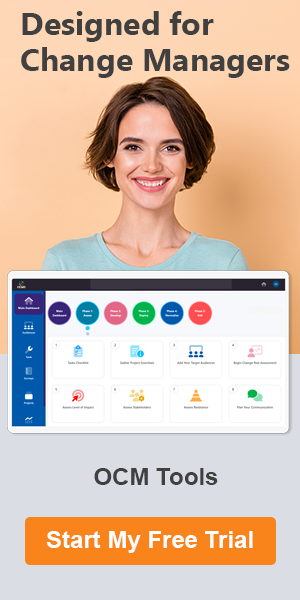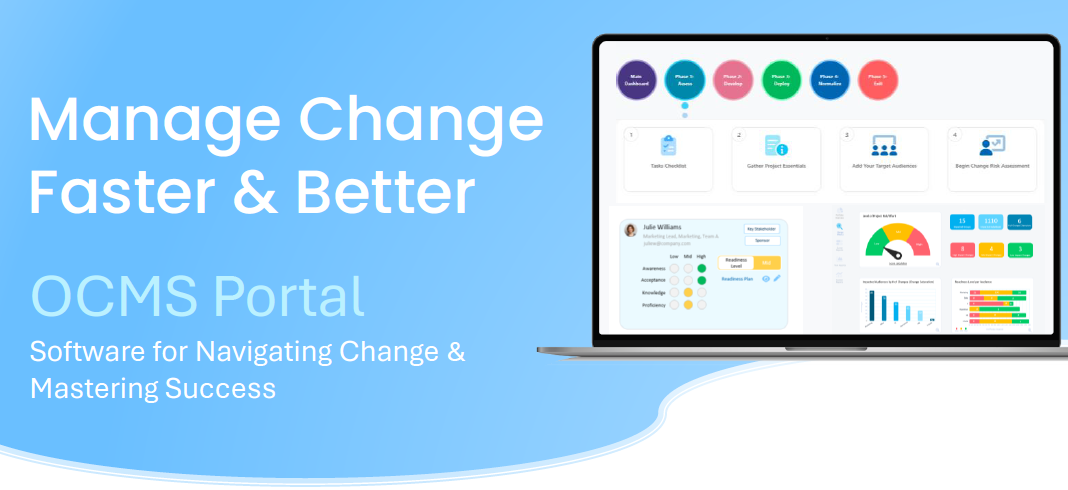Blending Agile and Change Management: A Modern Approach to Transformation
– Everything You Need to Know
So how do you effectively use change management in Agile? In this article, we’ll discuss how Agile and change management go hand-in-hand and share key strategies, benefits, and best practices for leading successful change management in an agile environment.
With business landscapes changing at lightning speed, companies are turning to agile OCM methods to stay ahead of the game and handle changes smoothly. Agile, which started in the world of software development, has shown itself to be a fantastic way to manage organizational transformations and drive change.
By weaving Agile principles into change management processes, project leaders and change practitioners can build more adaptable, responsive organizations.

Key Takeaways
|
Why Agile and Change Management Go Hand in Hand
At its core, Agile focuses on adaptability, customer collaboration, and responding to change over rigid planning. These principles align closely with the needs of modern organizations that must navigate frequent shifts in the marketplace, technology, and customer expectations. Integrating an Agile change management framework allows organizations to stay flexible while managing the human and organizational elements of change.
Traditional change management approaches may emphasize detailed upfront planning, which can hinder responsiveness in today’s fast-moving environment. In contrast, agile methodology change management promotes an iterative, feedback-driven approach that aligns with the need for continuous adaptation in both projects and organizational shifts.
By embedding an agile approach to change management, organizations can achieve greater speed, flexibility, and stakeholder engagement.
Please let us know if you have any questions about agile organizational change management or the steps for taking an agile approach to change management.
What are the Benefits of an Agile Change Management Process?
There are several important benefits of agile change management:
Flexibility and Adaptability
The Agile business transformation methodology allows for incremental changes, offering organizations the flexibility to adapt based on real-time feedback. Rather than implementing one large, overarching change, the Agile change management model enables organizations to introduce change in small, manageable iterations.
Improved Stakeholder Engagement
In an agile change management process flow, stakeholders are involved throughout the entire process. This continuous engagement ensures that all parties understand the evolving nature of the project and are better prepared to manage the outcomes. Increased transparency and communication reduce resistance to change.
Faster Time to Market
Agile change management processes emphasize quick, iterative releases, which allow organizations to implement changes faster. This is critical for maintaining competitiveness and ensuring that the organization remains responsive to external pressures.
Minimized Risk
Incremental delivery helps reduce the risks often associated with large-scale change projects. Each iteration can be adjusted based on feedback, ensuring that the final outcome is aligned with organizational needs and goals. Agile transformation management also allows project leaders to identify potential obstacles early in the process.
Do you have any questions or feedback related to change management agile transformation, creating an agile change management plan, or using change management in agile environment? Please reach out and let us know.
What Are the Key Components of an Agile Change Management Approach?
To effectively apply Agile for change management, project leaders and practitioners must adopt the following core principles:
1. Iterative Approach to Change
One of the primary distinctions between Agile change management examples and traditional change management is the iterative approach. Instead of introducing change all at once, Agile breaks it down into smaller, manageable phases. These phases allow for regular feedback and course correction.
For example, in an agile business transformation, the change management team may begin by rolling out a small process change to a limited group of users. Based on their feedback, the team can fine-tune the process before expanding it across the organization. This iterative agile change management process flow helps mitigate risks and ensures that changes are more closely aligned with business objectives.
2. Collaboration and Communication
Agile places a strong emphasis on cross-functional collaboration, which is crucial for successful change management. In an enterprise agile transformation, change leaders work closely with project teams, stakeholders, and end users to ensure that feedback is incorporated at every stage.
Regular communication is also vital for ensuring that stakeholders understand the purpose of the change and are equipped to support it. Change management in agile projects should include frequent check-ins, progress updates, and collaborative problem-solving sessions.
3. Continuous Feedback and Improvement
Agile encourages continuous feedback from stakeholders, which can be used to refine both the change process and the outcomes. This feedback-driven approach helps identify issues early, allowing for course corrections without derailing the entire project. In change management for agile projects, it’s essential to gather input from employees, customers, and other stakeholders to fine-tune the process and improve adoption.
Are you looking for more tips or guidance on OCM topics like agile change management best practices and agile transformation change management steps? Sign up for our change management newsletter!
Agile Change Management Frameworks
There are several frameworks and methodologies that combine Agile principles with change management practices. Below are a few key models:
1. Scrum for Change Management
Scrum is one of the most widely used agile frameworks and can be effectively applied to change management. In change management in Scrum, change initiatives are broken down into sprints, typically lasting 1-4 weeks. Each sprint focuses on a specific change goal, and at the end of each sprint, progress is reviewed, and adjustments are made as necessary when using change management in Agile Scrum.
Scrum roles such as the Scrum Master and Product Owner can also be adapted for change management. When doing change management in Scrum, the Scrum Master ensures that the change process is running smoothly, while the Product Owner represents the stakeholders’ interests and ensures that the change aligns with organizational goals.
2. Enterprise Agile Transformation
In large organizations, the shift to Agile often requires a more structured approach, known as enterprise agile transformation. This process involves not only adopting Agile at the team level but also scaling Agile principles across the entire organization.
Successful enterprise agile transformations often require a robust change management strategy to ensure that all levels of the organization are aligned with the new way of working.
An agile transformation management approach involves integrating change management principles such as stakeholder engagement, training, and communication into the broader agile transformation change management strategy.
Agile Change Management Best Practices
To ensure the success of your change management agile transformation initiatives, consider adopting the following best practices:
1. Create a Clear Change Vision
Even in an Agile environment, it’s essential to have a clear vision for what the change is intended to achieve. While the path to achieving that vision may evolve, a strong vision provides direction and ensures that all stakeholders are aligned with the ultimate goal.
2. Engage Employees Early and Often
Change management in an agile environment requires ongoing engagement with employees. Get employees involved from the beginning, and continue seeking their input throughout the process. This will help build buy-in and reduce resistance.
3. Use Agile Change Management Tools and Software
Leverage agile change management software to track progress, manage feedback, and facilitate communication. Agile change management process tools such as OCMS Portal can help streamline the change management process, ensuring that all stakeholders are aligned and that feedback is incorporated in real time.
4. Prioritize Training and Support
As you implement changes, make sure that employees have the training and support they need to adapt to new processes. Regular workshops, training sessions, and resources should be part of your agile change management plan.
5. Measure Success and Adjust as Needed
Agile encourages continuous improvement. Make sure you’re tracking key agile and change management metrics to assess the success of your change initiatives, and be ready to adjust your approach as needed based on feedback and performance data.
Please reach out and let us know if you have any questions about using Agile for change management, agile change methodology, or the benefits of Agile change management framework.
Case Studies: Agile Methodology Change Management in Action
Let’s look at a few agile change management examples to see how organizations have successfully integrated Agile principles into their change management efforts.
Example 1: Financial Services Agile Transformation
A large financial services firm undertook an agile change management model transformation to improve its product development processes. The change management team used Agile change methodology to introduce new processes incrementally, gathering feedback from employees after each sprint.
This iterative approach allowed the firm to fine-tune its new processes and ensure that employees were on board with the changes, leading to improved productivity and faster time to market.
Example 2: Agile Approach to Change Management in IT Projects
An IT company used an agile change management approach to roll out a new software platform across the organization. By using the Scrum framework, the change management team broke the implementation into sprints, allowing employees to test the software in phases. This change management in the Agile Scrum approach minimized disruption and allowed the team to address any technical issues before the full roll-out.
Conclusion: Embracing Agile Methodology Change Management
Agile change management methodology offers a flexible, adaptive approach to navigating organizational change. By adopting the principles of Agile in change management, OCM practitioners and project leaders can ensure that changes are implemented smoothly, with continuous feedback and minimal disruption. The benefits of change management for Agile transformation —ranging from increased stakeholder engagement to faster implementation—make it an ideal framework for organizations looking to thrive in today’s fast-paced business environment.
For change management practitioners, embracing change management in agile methodology offers a path to not only managing change more effectively but also creating more resilient, adaptable organizations ready to tackle future challenges.
Do you have any feedback or questions about Agile business transformation or Agile and change management? Please let us know. We’ll be happy to help!
Best Agile Change Management Software
OCMS Portal is a leading platform designed especially for change management. It includes all the tools you need to manage agile business transformations end-to-end.
With Agile methodology compatibility, feedback surveys, and rich analytics reporting, it gives change management practitioners what they need to use an iterative approach to change.
Start leveraging a change management process agile approach and the software to help you do it easily. Sign up for a free no-risk trial today.
FAQ: Agile and Change Management
What is Change Management in Agile?
Using a change management process Agile approach means incorporating Agile and Agile Scrum principles into change management. Agile methodology change management promotes an iterative, feedback-driven approach that aligns with the need for continuous adaptation in both projects and organizational transformations.
How do you use change management in Scrum?
In change management in Scrum, change initiatives are broken down into sprints, typically lasting 1-4 weeks. Each sprint focuses on a specific change goal, and at the end of each sprint, progress is reviewed, and adjustments are made as necessary when using Scrum for change management for agile projects.
What are the benefits of using an agile change management process?
The benefits of using an agile change management framework include flexibility and adaptability, improved stakeholder engagement, faster time to market, and minimized risk.
Note: Content on OCM Solution's ocmsolution.com website is protected by copyright. Should you have any questions or comments regarding this OCM Solutions page, please reach out to Ogbe Airiodion (Change Management Lead) or the OCM Solutions Team today.
External Sources: stock.adobe.com






